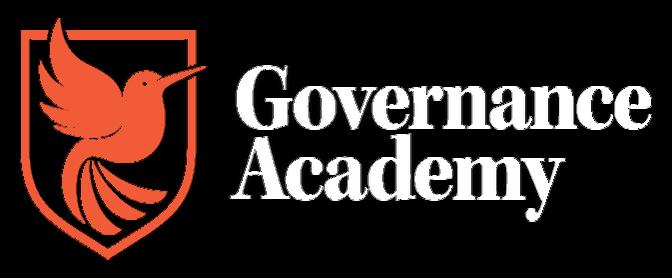‘Lift your gaze’: Smith Family CEO urges leaders to address disadvantage




‘Lift your gaze’: Smith Family CEO urges leaders to address disadvantage



A national membership association, Governance Institute of Australia advocates for a community of governance and risk management professionals, equipping members with the tools to drive better governance within their organisation.
Our contact details
National office 1800 251 849 (02) 9223 5744
Level 11/10 Carrington Street, Sydney NSW 2000
customerservice@governanceinstitute.com.au
Call us on: 1800 251 849
Submissions:
Members of Governance Institute and others are welcome to submit articles for consideration. Please contact the editorial office for details and guidelines at media@governanceinstitute.com.au
Disclaimer:
All expressions of opinion in this journal are published on the basis that they are not to be regarded as expressing the official opinion of Governance Institute of Australia, unless expressly so stated. Governance Institute of Australia, authors and all persons involved in the preparation and distribution of this journal, are not thereby giving legal, accounting or other professional advice and hence do not accept any responsibility for the accuracy of any of the opinions or information contained in the journal. Readers should not act or refrain from acting on the basis of opinions or information without first taking appropriate professional advice in respect of their own particular circumstances. Governance Institute of Australia does not accept any liability to advertisers for the publication of advertisements which may be held to be contrary to law. Material published in is copyright and may not be reproduced without permission. Governance Directions
Dear Members,
I am very honoured to be stepping into the role as Interim CEO of Governance Institute
It’s an exciting time to be collaborating with all of you as we continue to innovate and lead in our field With a shared vision for responsible progress, I am committed to advancing the mission of this organisation, while fostering strong, transparent relationships with you, our partners, our students and other stakeholders
I would like to thank Megan for her service to the Institute as CEO for the past six years and wish her all the very best for her next adventure. We’re very lucky she’ll remain with us as a valued member!
As part of my initial focus, I have reviewed the latest thought leadership report, the 2025 AI Deployment and Governance Survey which highlights the increasing need for responsible AI practices and outlines key steps a range of organisations are taking to address these challenges
The report has found that while the adoption of artificial intelligence is accelerating across Australian businesses, a growing divide is emerging between the largest organisations and their smaller and not-for-profit counterparts
Respondents to the survey said significant barriers preventing some organisations from harnessing AI’s potential include gaps in governance, insufficient training, and uncertainty about measuring AI’s return on investment
Given small businesses account for 98 per cent of the Australian business community, limited AI adoption could pose a significant risk to future competitiveness and productivity
The report makes clear that organisations need to prioritise AI literacy, invest in training, and develop robust governance frameworks to harness the potential of AI safely and effectively
Featuring in-depth case studies and practical guidance about various AI journeys, best practices and the role of government initiatives - including the Voluntary AI Safety Standard - the report should be a useful tool to help drive responsible AI use for your organisation, big or small
As a leader in governance, we recognise the importance of not only advancing the capabilities of AI but also ensuring that these advancements benefit society and adhere to ethical and regulatory frameworks This report is a key reflection of our commitment to transparency, safety, and accountability as we work together to build the future of AI
We invite you to read the full report and survey, together with the other valuable insights in this journal on NFP governance, the WGEA gender pay gap and the recently handed down Federal Budget.
Thank you for your continued membership and trust in the Governance Institute and I look forward to what we will accomplish together
Best regards, Katrina
Katrina Horrobin, Interim CEO Governance Institute of Australia




Embedding accountability in governance and risk frameworks
WA Tuesday, 6 May 2025 - Pan Pacific, Perth
SA Thursday, 8 May 2025 - U City, Adelaide
QLD Wednesday, 14 and Thursday, 15 May 2025 - Hotel Grand Chancellor, Brisbane
VIC Thursday, 22 and Friday, 23 May 2025 - Sheraton, Melbourne
NSW Thursday, 29 and Friday, 30 May 2025 - Intercontinental, Sydney



The 2025 AI Deployment and Governance Survey Report highlights the need for improved training and governance frameworks.
Australian businesses of all sizes are experiencing difficulty in integrating generative AI into legacy systems, with 88 per cent of respondents of Governance Institute’s 2025 AI Deployment and Governance Survey Report indicating unsuccessful attempts
This challenge is compounded by a lack of training, which hinders the effective deployment of AI technologies. The survey found that only 10 per cent of respondents have advanced or formal qualifications in AI, while a staggering 46 per cent have not undertaken any training at all.
The 2025 AI Deployment and Governance Survey Report, conducted by Governance Institute of Australia, sheds light on the current state of AI adoption, governance, and training across various sectors The report was sponsored by the National AI Centre, Diligent and PKF
The survey of 344 professionals across various industries found that nearly 90 per cent of respondents report some level of AI use within their organisations.

Despite this widespread adoption, significant disparities exist between large corporations and smaller entities Large organisations, particularly those listed on the ASX, are leading the way in AI integration, while smaller businesses and not-forprofits lag
The divide poses a risk to the overall competitiveness and productivity of the Australian economy, as small enterprises, which make up 98 per cent of the business community.
Artificial intelligence (AI) is rapidly transforming the landscape of Australian businesses, offering significant opportunities for innovation, efficiency, and growth.
The journey to harnessing AI's full potential is hampered by challenges however, particularly for small and not-for-profit organisations


When asked about plans for future training in their organisation, only three per cent of respondents said their organisations plan to offer formal, accredited training programs in the next 12 months. Instead, 50 per cent plan to offer informal, unaccredited training, and 45 per cent have no plans for training.
This lack of structured training programs highlights the need for a more robust approach to AI education and skill development
The primary barriers to managing staff adoption of AI are a lack of knowledge and understanding, as well as resource constraints Financial limitations and poor digital literacy are significant impediments, with 55 per cent of respondents citing staff training and digital literacy as major challenges.
Additionally, 72 per cent of respondents mentioned data privacy as a regulatory impediment, highlighting the complex landscape of AI governance.
Effective governance frameworks are crucial for the responsible deployment of AI
“THE TRANSITION TO A CLEAN ECONOMY WILL REQUIRE NEW SKILLS; AN AGEING POPULATION WILL REQUIRE OUR SKILLS TO BE REFRESHED.”
Ethical considerations and data privacy are also paramount. Organisations are employing a range of measures to ensure compliance with regulations and ethical standards, including policies, training, and adherence to the Voluntary AI Safety Standard
Despite these efforts, the report underscores the need for continuous improvement and vigilance in AI governance


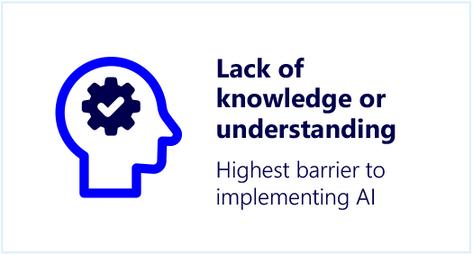
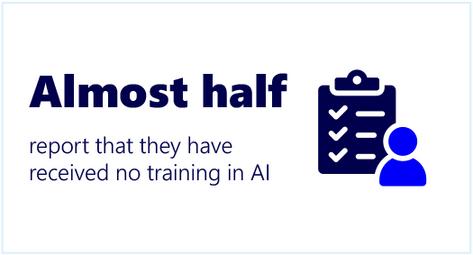
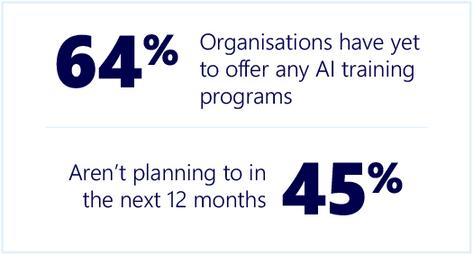
Another area focused on in the survey was the impact of Generative AI and its potential to revolutionise various aspects of business operations, from content creation to coding efficiency and data analysis However, its full impact is still being assessed, and organisations must navigate the complexities of integrating this technology into their existing workflows
The report provides valuable insights into the current state of AI adoption in Australia. While large organisations are making significant strides, smaller businesses and not-for-profits face considerable challenges.
Addressing these barriers requires a concerted effort to improve AI literacy, invest in training, and develop robust governance frameworks

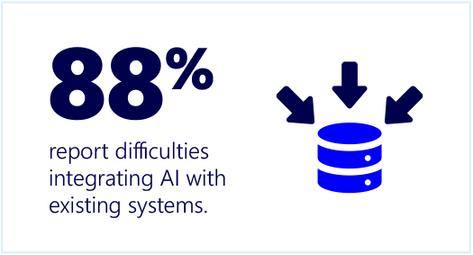
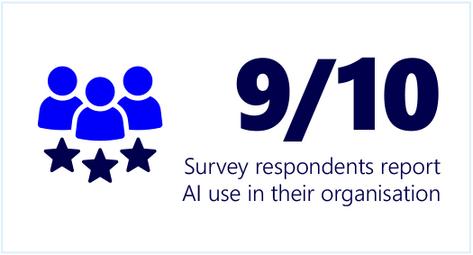
In doing so, Australian businesses can harness the transformative power of AI in an ethical and responsible manner, ensuring long-term competitiveness and growth
As Pauline Vamos, Chair of the Governance Institute of Australia, stated, "Organisations of all sizes need to prioritise AI literacy, invest in training, and develop robust governance frameworks to harness AI’s potential safely and effectively." The findings of this report serve as a call to action for all stakeholders to work together in building a future where AI benefits everyone.
You can read the 2025 AI Deployment and Governance Survey Report on our website

By Doug Taylor, Chief Executive Officer of The Smith Family

Today’s governance leaders are more than stewards of compliance and shareholders’ interests.
They must have a deep understanding of how social, economic, and environmental issues affect not only the organisations they lead but also the communities in which they live, work and depend upon
Board members, CEOs, and other decision-makers have an opportunity – a responsibility – to be navigators and drivers of solutions to pressing contemporary societal challenges. Without solutions, the sustainability of their organisations is at risk.
While we empower governments to play this role, our organisations have a vital contribution and interest. Our institutions’ success – or failure – hinges on our ability to balance the needs and interests of our businesses and those of the broader community, recognising that these are not opposite ends of a continuum but deeply intertwined
“You cannot operate a successful institution in a failed world.”

To borrow a phrase that has always underpinned my approach: “You cannot operate a successful institution in a failed world.”
Much has been written about these social responsibilities of governance, including a Harvard Business School working paper by my colleagues Kristy Muir and Shamal Daas, in collaboration with Harvard Professor Kash Rangan They offer a crucial insight for leaders:
"It is time to lift your gaze and see the system"
While the article is framed for not-for-profit boards, there are broader implications given the changed societal expectations of business There is a call to action for governance leaders to look beyond their own organisations and consider the larger ecosystem of structures, policies, and systems they operate within.
They ask leaders to think about the influence they can bring to bear to help solve the broader social challenges that, ultimately, affect us all.

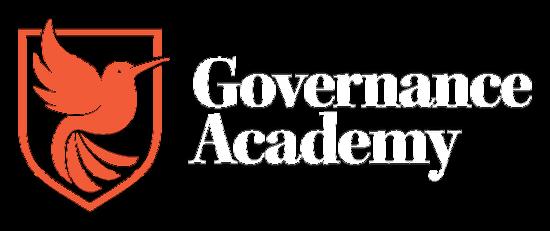
Right now, one of the most pervasive of those social challenges –and one I have witnessed firsthand throughout my career – is people’s experience of poverty
In Australia, 1.2 million children and young people wake up each day in families struggling to make ends meet. Without intervention, this can have immediate and longer-term life-altering impacts.
As governance leaders, understanding the impacts of disadvantage is not just an ethical necessity, it is a practical, strategic imperative. I’vemet many young people with enormous potential but limited opportunities due to poverty
It may seem trivial that a child’s family cannot afford their school uniform But students have told me how that made them feel excluded; it affected their attendance and, in turn, their grades and ultimately the likelihood of their completing school
At some point, whether personally, or through family or friends, each of us will face life changes exposing us to some dimension of poverty. I, for one, want to live in a country where a robust social safety net supports those in need. But our net is fraying, and we must work together to strengthen it.
Unchecked disadvantage burdens taxpayers and weakens social cohesion. Though to me, the biggest cost is the lost human potential. If we don’t allow all young people – no matter their background – to realise their full potential, we aren’t just missing opportunity; we’re setting up our organisations for greater challenges down the line
The job market is rapidly changing, with many low-skilled, entrylevel positions vanishing or evolving into roles demanding advanced skills, particularly digital literacy Experts predict over 90 per cent of future jobs will require post-school qualifications
Find out more
But in our country, educational inequity is limiting opportunities for students experiencing disadvantage Despite the best efforts of teachers and parents, they are less likely to finish school and pursue tertiary study Systemic reform is long overdue
Educational inequity is both a social and a business issue If we don’t address it, we risk a future with fewer skilled young people in the workforce, narrowing our talent pool and limiting our capacity to innovate and adapt. This undermines our business competitiveness and, ultimately, its viability.
Solving poverty and other social challenges requires collaboration. No single organisation or idea can overcome these issues alone. We must break down silos between business, government, and non-profits, to create a unified, collaborative social economy
We need the full implementation of the Better and Fairer Schools Agreement, and we need the practical engagement of businesses in schools and, in particular, in careers education
The Smith Family’s Cadetship to Careers program, which provides internships to young students experiencing disadvantage, is one example of what that collaboration can look like. Since the program began in 2017, it has worked with over 50 businesses, offering companies like Accenture, Macquarie Group, Officeworks, and Qantas a way to not only fill temporary roles but also mentor and develop future leaders
Such partnerships bring diversity, equity, and inclusion strategies to life, nurturing the next generation while practically tackling long-term social challenges A diverse, inclusive workforce is essential
Employees with lived experience of hardship offer new and valuable insights into customer needs, creating better-informed businesses and stronger community connections.
Decades ago, when I first started my career, I was a community worker in inner-city Sydney, supporting people dealing with poverty, homelessness and addiction It taught me the importance of seeing the bigger picture – not just managing the problems people experience but helping them achieve their goals and thrive through the power of education
For over 20 years, I’ve carried these lessons into my CEO and board roles, keeping governance outwardfocused with community needs and interests at the heart. That’s why I teach Governance for Social Impact with The Centre for Social Impact at the Australian Graduate School of Management.
Good governance is about balancing your organisation’s goals with the needs of the communities it serves. It is about leveraging your institution’s unique drivers to forge meaningful partnerships and genuinely contribute to solving pressing societal challenges
Every organisation’s sustainability – its very future –is deeply connected with the wellbeing of our communities Today, we all have not only an opportunity, but a responsibility, to lift our gaze to the bigger picture. Working alongside one another, we can create a more equitable Australia and make a positive impact for the generations who follow us. I cannot think of more meaningful focus, nor legacy, for any governance leader.

Doug Taylor is the CEO of The Smith Family, a children’s education charity He also teaches Governance for Social Impact at the Australian Graduate School of Management with The Centre for Social Impact.
The World Economic Forum’s Future of Jobs Report 2025 offers a fascinating glimpse of the core skills that will be essential for the workforce in the coming years.



The bi-annual World Economic Forum (WEF) Future of Jobs Report 2025, tracks the evolving technological, societal, and economic trends to understand occupational disruption and identify future job opportunities
The 2025 edition focuses on the impact of generative AI and other technological advancements, alongside economic, environmental, and societal challenges, based on insights from over 1,000 global employers.
The report indicates that 39 per cent of workers' core skills are expected to change by 2030 This represents a significant, albeit slightly reduced, level of disruption compared to previous years
The stabilisation in the pace of skill disruption can be attributed to the increasing focus on continuous learning, upskilling, and reskilling programs. These initiatives have enabled companies to better anticipate and manage future skill requirements.
However, the extent of skill disruption varies across economies and industries Lower-middle and upper-middle-income economies, as well as those affected by conflict, tend to expect greater disruption in workers' skills In contrast, highincome economies foresee less instability
The report identifies several core skills that are essential for workers today. Analytical thinking remains the top core skill, with seven out of ten companies considering it essential This is followed by resilience, flexibility, and agility, along with leadership and social influence
These skills underscore the critical role of adaptability and collaboration alongside cognitive abilities.
Other important core skills include:
Creative thinking: The ability to generate innovative ideas and solutions
Motivation and self-Awareness: Understanding one's strengths and weaknesses and being driven to improve
Technological literacy: Proficiency in using digital tools and understanding technological trends
Empathy and active listening: The ability to understand and respond to others' emotions and perspectives.
Curiosity and lifelong learning: A commitment to continuous learning and staying updated with new knowledge and skills.
Talent management: The ability to attract, develop, and retain talent.
Service orientation and customer service: Providing excellent service and meeting customer needs.
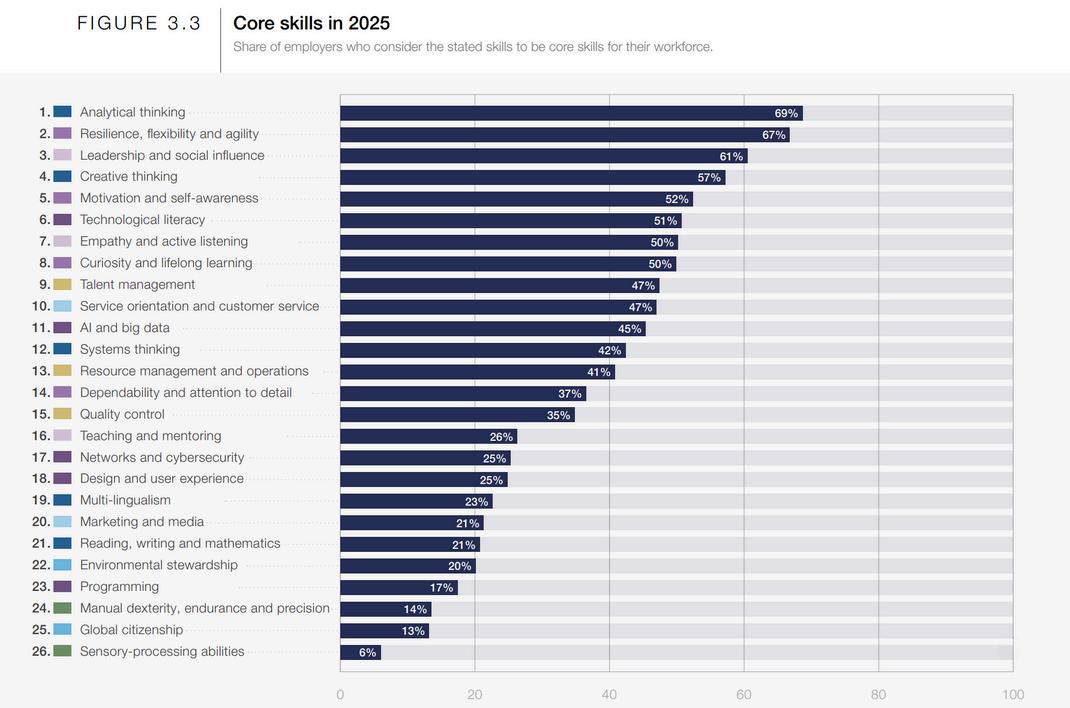
The report projects that technological skills will grow in importance more rapidly than any other type of skill. Among these, AI and big data top the list as the fastest-growing skills, followed closely by networks and cybersecurity and technological literacy.
Complementing these technological skills, creative thinking, resilience, flexibility, and agility, along with curiosity and lifelong learning, are also seen as rising in importance
Other skills expected to increase significantly in use by 2030 include leadership and social influence, environmental stewardship, systems thinking and empathy and active listening
Networks, cybersecurity and environmental stewardship rank among the top 10 skills expected to
increase significantly in use by 2030, yet they are not currently considered core skills for most organisations.
These emerging skills represent areas where businesses may need to anticipate growing demands and develop capabilities before they become critical
On the other hand, skills that are core today but expected to remain stable over the next five years without significant increase in use include empathy and active listening, service orientation and customer service, and resource management and operations.
Skill differences between growing and declining jobs
The report also highlights the differences in skill requirements between growing and declining jobs.
Programming and technological literacy differentiate growing and declining roles, reflecting the increasing integration of technology across occupational fields. While programming scores higher in importance, it requires less proficiency compared to technological literacy
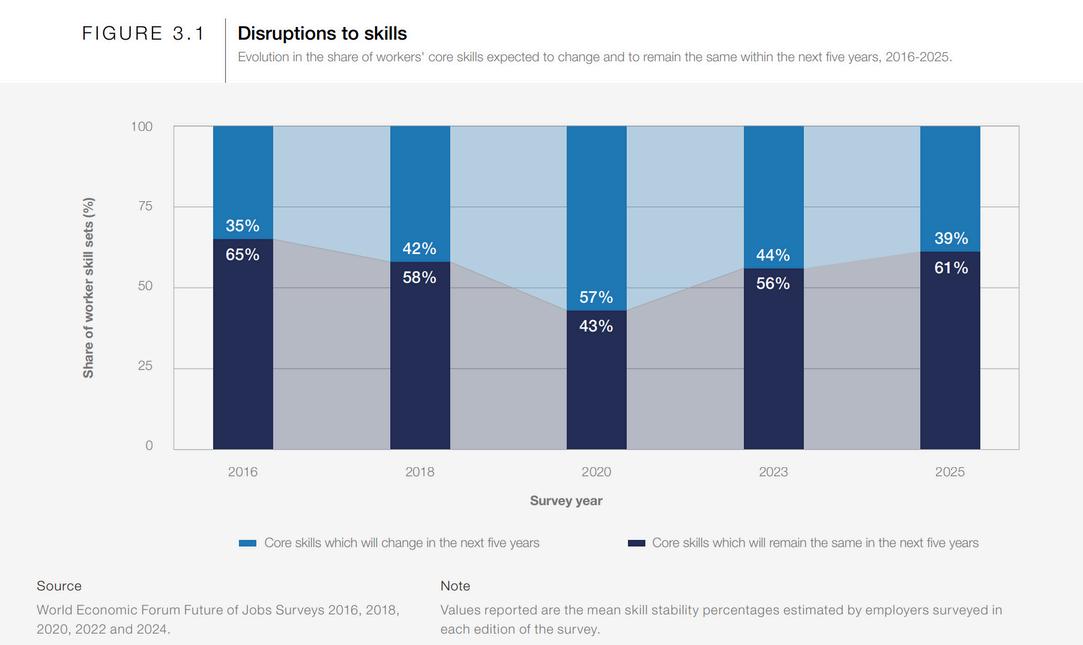
Resource management and operations, and quality control skills also show marked gaps in both proficiency and importance. Analytical thinking completes the list of top five skills for the importance gap, while ranking sixth for the skill proficiency gap.
In roles where manual skills remain critical, businesses are seeking a higher degree of specialisation that combines manual abilities with technological literacy and problem-solving skills. Growing roles demanding high manual skill proficiency include drafters, engineering and mapping technicians, electrotechnology engineers, mechanics, machinery repairers, and solar energy installation engineers
By contrast, declining roles, such as printing trades workers and transportation attendants, generally require lower levels of manual skill proficiency
Technological advances are expected to drive skills change more than any other trend over the next five years, driven by the expansion of digital access and the integration of AI and information processing technologies
These trends are not only seen as responsible for the growth of these three fastest-growing skills but also for the rising importance of analytical thinking and systems thinking. These shifts highlight the increasing complexity of decision-making and the need for critical problem-solving in a data-driven world.
Beyond the top 10 fastest-growing skills, design and user experience, along with marketing and media skills, are also expected to see growth driven by technological advancements.
These skills are closely linked to digital transformation, reflecting the rising importance of delivering seamless digital experiences and understanding the impact of consumer behaviour

Interestingly, while programming remains stable as an in-demand skill, both respondents expecting growth in its use and those expecting decline consistently point to technological change as the primary driver behind this change. This highlights the dual effect of technology, underscoring how the same technological forces that drive job creation may also contribute to job displacement.
A number of key areas are expected to shape the global labour market from 2025 to 2030. The increasing cost of living is ranked as the second-most transformative trend, with half of the employers expecting it to impact their businesses by 2030.
Additionally, a general economic slowdown is expected to transform 42 per cent of businesses, potentially displacing 16 million jobs globally
Climate change and sustainability are critical factors driving labour market changes Climate-change mitigation is the third-most transformative trend, driving demand for roles such as renewable energy engineers and environmental engineers. Climatechange adaptation is expected to transform 41 per cent of businesses, bringing focus to the need for environmental stewardship.
Geopolitical factors like trade restrictions and government policies are increasingly influencing the global job market. These dynamics are expected to drive business transformation for a third of employers, highlighting the interconnectedness of global systems and their impact on employment trends
Significant demographic shifts, with aging and declining working-age populations predominantly in higherincome economies and expanding working-age populations mainly in lower-income economies will also influence labour market dynamics and workforce planning.
The report projects that technological skills will grow in importance more rapidly than any other type of skill
Among these, AI and big data top the list as the fastest-growing skills, followed closely by networks and cybersecurity and technological literacy.
Complementing these technological skills, creative thinking, resilience, flexibility, and agility, along with curiosity and lifelong learning, are also seen as rising in importance.
Every organisation should begin preparing for the upcoming wave of potentially powerful generative artificical intelligence (GenAI) applications on their business.
Other skills expected to increase significantly in use by 2030 include leadership and social influence, environmental stewardship, systems thinking and empathy and active listening
Networks, cybersecurity and environmental stewardship rank among the top 10 skills expected to increase significantly in use by 2030, yet they are not currently considered core skills for most organisations
These emerging skills represent areas where businesses may need to anticipate growing demands and develop capabilities before they become critical
On the other hand, skills that are core today but expected to remain stable over the next five years without significant increase in use include empathy and active listening, service orientation and customer service, and resource management and operations.
Skill differences between growing and declining jobs
The report also highlights the differences in skill requirements between growing and declining jobs. Programming and technological literacy differentiate growing and declining roles, reflecting the increasing integration of technology across occupational fields
While programming scores higher in importance, it requires less proficiency compared to technological literacy

Structural labour-market transformation is a key theme in the report, predicting that job creation and destruction will amount to 22 per cent of today’s total jobs by 2030 This transformation involves significant shifts in employment across sectors, driven by technological advancements, economic changes, and demographic trends. For example, the rise of AI and automation is expected to create new job opportunities in tech-related fields while displacing roles in traditional manufacturing and administrative sectors.
Additionally, the green transition will generate demand for jobs in renewable energy and environmental management, while economic slowdowns may lead to job losses in other areas This dynamic landscape underscores the importance of reskilling and upskilling workers to navigate the evolving job market
Workers, employers, and policymakers must collaborate to navigate these changes, ensuring that the workforce is properly equipped with the skills needed to thrive in the future of work.
To develop the skills and capabilities highlighted by the WEF report, the Governance Capability Framework and CapabilityPro are the perfect solutions.
The result of extensive psychometric research, CapabilityPro evaluates your current core strengths and areas for growth across the 22 essential professional, technical, and human capabilities as part of the Governance Capability Framework
Many of the capabilities referred to in The Future of Work report including Sustainability Reporting, ESG, Systems Thinking & Viability, Leading, Critical & Independent Thinking, Empathy & Inclusion are among our key courses available for you to start right now.
Head to our Academy page for more information.

The latest Report from the Workplace Gender Equality Agency (WGEA) confirms that gender inequality in pay remains a significant issue across Australian workplaces The Employer Gender Pay Gaps Report found that on average, women earn 78 cents for every dollar earned by men, resulting in a total average remuneration gender pay gap of 218 per cent and a base salary gender pay gap of 16.7 per cent.
While this gap has been slowly narrowing, the report reveals that progress is uneven across industries, employer sizes, and pay quartiles. It also highlights the ongoing issue of women being significantly underrepresented in the highest-paid roles, even in industries where the workforce is more evenly split between men and women
The report found that a key contributor to the gender pay gap is the concentration of men in higher-earning positions In almost every industry, men are more likely to be employed in the highest-paying roles compared to their overall representation in the workforce.
Despite progress, men are 1.9 times more likely to hold top-paying roles, highlighting ongoing inequality in the workforce.

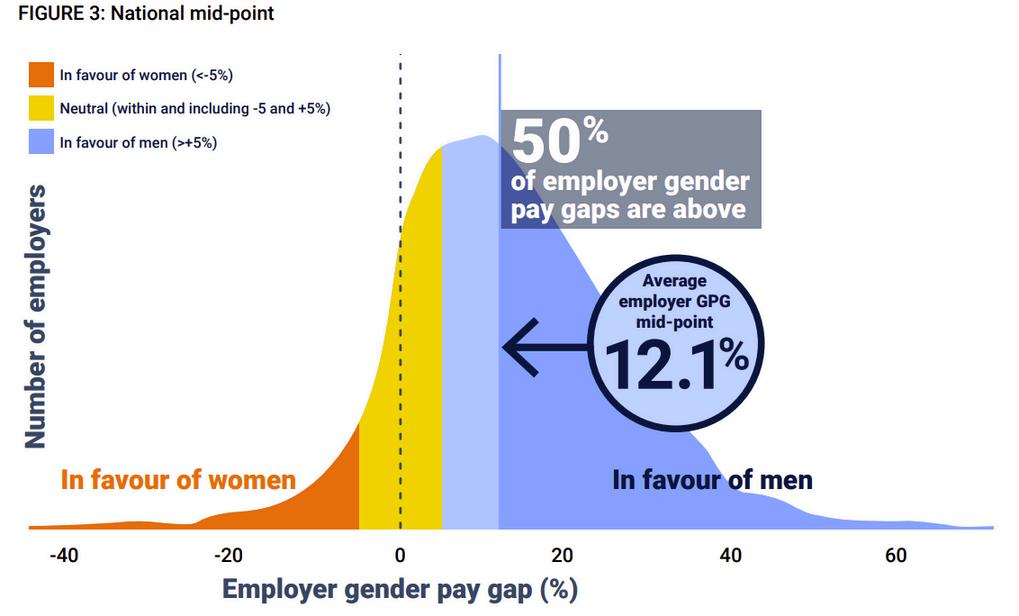
At a national level, women are 15 times more likely to be in the lowest remuneration quartile, while men are 19 times more likely to be in the upper quartile This imbalance is particularly stark in high-paying industries such as mining, where only 16 per cent of top-quartile earners are women, despite women making up 22 per cent of the workforce
Similarly, in financial and insurance services, which has a gender-balanced workforce (53 per cent women), only 36 per cent of employees in the highest pay quartile are women, contributing to a mid-point gender pay gap of 22.2 per cent.
These findings suggest that even when there is a healthy pipeline of female talent in an industry, employers ‘may be struggling with a promotional problem’
One of the most significant contributors to the pay gap, according to WGEA’s report, is the difference in additional earnings beyond base salary Total remuneration includes superannuation, bonuses, overtime, and other discretionary payments, categories where men consistently receive more than women.
On average, men earn $11,204 more per year in these additional payments, further widening the gap This trend is even more pronounced in high-paying industries like mining, where men earn $55,281 more in total remuneration than women, largely due to discretionary pay components such as bonuses and overtime
The impact of industry-wide pay rates is another key factor shaping gender pay disparities. Even in industries where women reach the upper pay quartile at similar rates to men, their earnings tend to be significantly lower than those in male-dominated industries.
For example, the average total remuneration for a topquartile worker in accommodation and food services is $115,076, which is less than the lowest quartile average in mining ($115,292)
This implies a structural issue where industries dominated by women tend to have lower overall pay scales, further contributing to national gender pay disparities
Despite these challenges, the report does highlight some encouraging trends. More employers are actively measuring and addressing gender pay gaps, with 68 per cent of organisations conducting a gender pay gap analysis in 2023-24, a critical first step in closing the gap.
Larger organisations tend to have smaller gender pay gaps, with employers of 5,000+ people reporting a mid-point gender pay gap of nine per cent, compared to 133 per cent for smaller employers with fewer than 250 employees This suggests that larger organisations, which often have structured HR policies, formal pay scales, and diversity initiatives, may be making more progress in addressing gender pay disparities.
A part of this resides with the reporting of gender pay gaps. With gender pay gaps now published annually, the Workplace Gender Equality Amendment (Closing the Gender Pay Gap) Act 2023 introduced new obligations for employers to enhance transparency and accelerate progress on workplace gender equality, bringing increased public scrutiny to employer performance in this space
Under the amended Act, CEOs are required to share key gender equality reporting documents with their board or governing body These include:
An Executive Summary, which provides an overview of an organisation’s gender equality performance against six key indicators.
An Industry Benchmark Report, which compares the organisation’s data with industry peers to identify strengths and areas for improvement.
These documents must be shared as soon as reasonably practical after WGEA releases the Industry Benchmark Report, which occurred in early November 2024 Find out more about these obligations
For boards and executives, these new requirements shouldn’t just be a compliance exercise, they present an opportunity to drive real change In the UK, where gender pay gap reporting has been in place since 2017, 70 per cent of organisations reported greater board engagement on the issue, with 63 per cent discussing the gender pay gap at the board level and 47 per cent taking direct action to address it.
To ensure these reports lead to meaningful discussions and decisions, directors should ask:
What are the key drivers of gender inequality evident in our data?
What expectations is the board setting for management to improve workplace gender equality? What actions and resources are being invested in closing the gender gap?
How are gender equality outcomes reflected in CEO and executive KPIs?
How will the board track progress and hold leadership accountable?
With gender pay gap data now public, boards that fail to engage with these reports risk reputational damage and missed opportunities for improvement
Encouragingly, governance and leadership structures are also evolving to better reflect gender diversity. The 2024 Board Diversity Index, a collaboration between Governance Institute of Australia and Watermark Search International, found that women now hold 36 per cent of ASX 300 board positions, up from 35 per cent in 2023.
While this represents steady progress, the target of 40 per cent women, 40 per cent men, and 20 per cent flexible has only been achieved by 41 per cent of ASX 300 boards Additionally, 13 ASX 300 boards still have no female directors, showing that despite improvements, gaps remain at the top levels of corporate leadership The number of board positions held by women has increased by 89 per cent since 2015, reflecting long-term positive momentum
Encouragingly, governance and leadership structures are also evolving to better reflect gender diversity.
However, progress is not uniform While 56 per cent of employers reduced their gender pay gap over the past year, 44 per cent saw an increase Notably, the greatest reduction in median gender pay gaps occurred in maledominated industries, where the mid-point decreased by 13 percentage points, compared to 02 percentage points in women-dominated sectors
This could indicate that industries with the most significant disparities are facing greater scrutiny and taking stronger action in response
The WGEA report makes it clear that transparency, accountability, and cultural change are crucial in driving gender pay equity Employers that conduct regular pay gap analyses, set clear gender targets, and implement policies to support equitable promotion pathways are better positioned to reduce disparities.
Boards and executives play a particularly important role in ensuring that diversity is embedded into corporate governance frameworks, rather than treated as an optional initiative. Without proactive leadership, the structural factors that contribute to the gender pay gap, such as barriers to promotion, discretionary pay imbalances, and industry-wide pay discrepancies, will persist
For more insights, explore WGEA’s full findings: WGEA Employer Gender Pay Gaps Report



Analysis by Daniel Popovski

As the 2025 Federal Election kicks off, we ask whether the Government’s pitch to voters and particularly, Australia’s business community, will be enough to keep them in power for the next three years.
The Federal Budget papers that were never meant to be illustrated a highly uncertain economic environment ahead.
From geopolitical tensions in Europe and the Middle East, to a full-scale trade war led by the US, we are potentially witnessing the greatest unravelling of global security ties and capital flow that have kept cross-border peace and economic prosperity, for the most part, since the Second World War
Increasing global security concerns not only rattles business investment leading to less certain and
more risk-averse business investment, but it also impacts households, resulting in more savings and less spending
The Government is expecting monetary policy to do most of the heavy lifting by reducing interest rates and borrowing costs throughout the year to encourage greater spending and cash circling through the economy.
But monetary policy alone can’t resolve the increasingly uncertain and complex business environment.
A more uncertain business environment means greater risk aversion and less investment in capital, both physical assets and people, and some may delay, divert or forgo investment plans, taking a sit and wait approach

Jim Chalmers told Australians on Tuesday night that the economy was turning a corner But a closer look at job data shows a somewhat illusionary story as most new jobs created over the past 12 months have come from public service-related industries, such as servicing the ever-expanding participation numbers of the NDIS – which is alone expected to cost the Australian taxpayer $48.5 billion this fiscal year, rising to over $63 billion by 2028-29.
It’s not what’s in the Budget but what’s missing that sends a clear signal from government on the role it expects to play alongside the Australia’s business community – that is, very little, to somewhat isolationist in its approach.

And where it has taken a more active approach, through the Future Made in Australia investment plan, it has heavily focused on picking winners by backing an uncompetitive renewable energy industry that is being outcompeted by China’s growing dominance in renewable energy.
Surprisingly, or not, the Budget underwhelmed the business community with no clear vision or strategy from the sitting Government on the future of Australia’s 266 million businesses that form the backbone of the economy
No new business incentives were on the table with the remaining instant asset write-off essentially being phased out completely. There were also no new funding announcements for businesses or workers to invest in digital technologies such as AI – which is set to create a once-in-a-generation growth opportunity for the Australian economy.
Internationally, the race to dominant AI markets is in full swing with the rapid onset of new capabilities such as Grok 3, Deepseek and Gemini, to name a few, across an increasingly broad domain of uses
While Australians are happy to embrace AI as part of their personal lives, with health and fitness apps, entertainment, retail and social media shaping what we buy, see and how we engage and interact with one another, AI as a tool in Australian workplaces is significantly trailing behind international peers. Recent evidence suggests more workers are using it outside of integrated systems and governance processes, creating immense risks to people and organisations.
Without going deeper into the risks and opportunities created by AI alone, it demonstrates government clearly needs to play a role in coordinating and incentivising investment, reducing barriers, complexity and friction in markets It will have to critically consider much needed competition reforms that will address the growing divide of across large, medium and smallsized businesses, with the latter at risk of becoming increasingly uncompetitive.
Last week’s Federal Budget lacked a clear strategy for a much-needed injection to Australia’s productivity growth story, its international competitiveness, and business resilience policies in an increasingly uncertain world.

Productivity-enhancing reforms are needed side by side with monetary policy to drive private sector investment, jobs, wages growth and higher living standards for all Australians Government could be doing more to establish the fundamentals for a productive, competitive and resilient business environment.
Working with the business community to identify, repeal and reinvent regulations that cause duplication and unnecessary costs to business and establishing a national corporate law reform body could help simplify and improve the integrity and coherence of the Corporations Act, reducing the burden on all stakeholders that interact with it, including regulators ASIC, APRA and the ACCC
Further investing in Australia’s AI strategy by setting clear and accessible AI standards and regulations could assist more businesses can adopt and deploy AI
Government could be doing more to establish the fundamentals for a productive, competitive and resilient business environment.
Driving certainty in sustainability, by ensuring government stays the course on climate policy will boost business and investor confidence.
A clear strategy from government that it plans to back business, should consider at the very least a conversation to kick start productivity-enhancing reforms, lower costs and the unnecessary complexity of doing business, and a private sector led job creation agenda, to allow for new, higher paying roles
The risk of not doing so, is a risk of another lost decade of productivity and with it, a continued deterioration of our living standards.

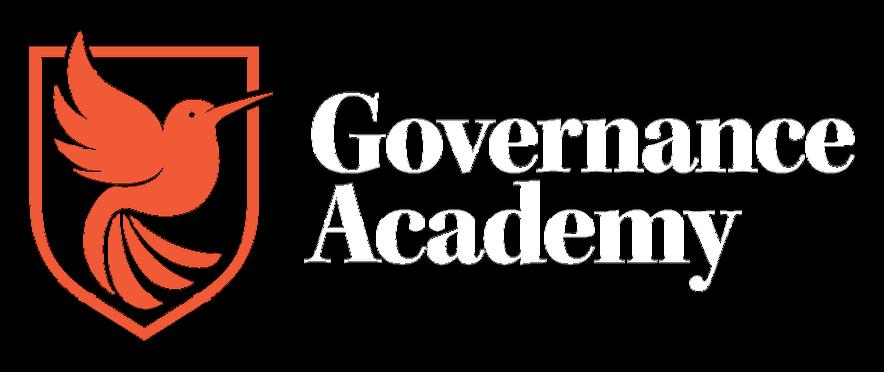
Expand your knowledge and expertise in governance and risk.
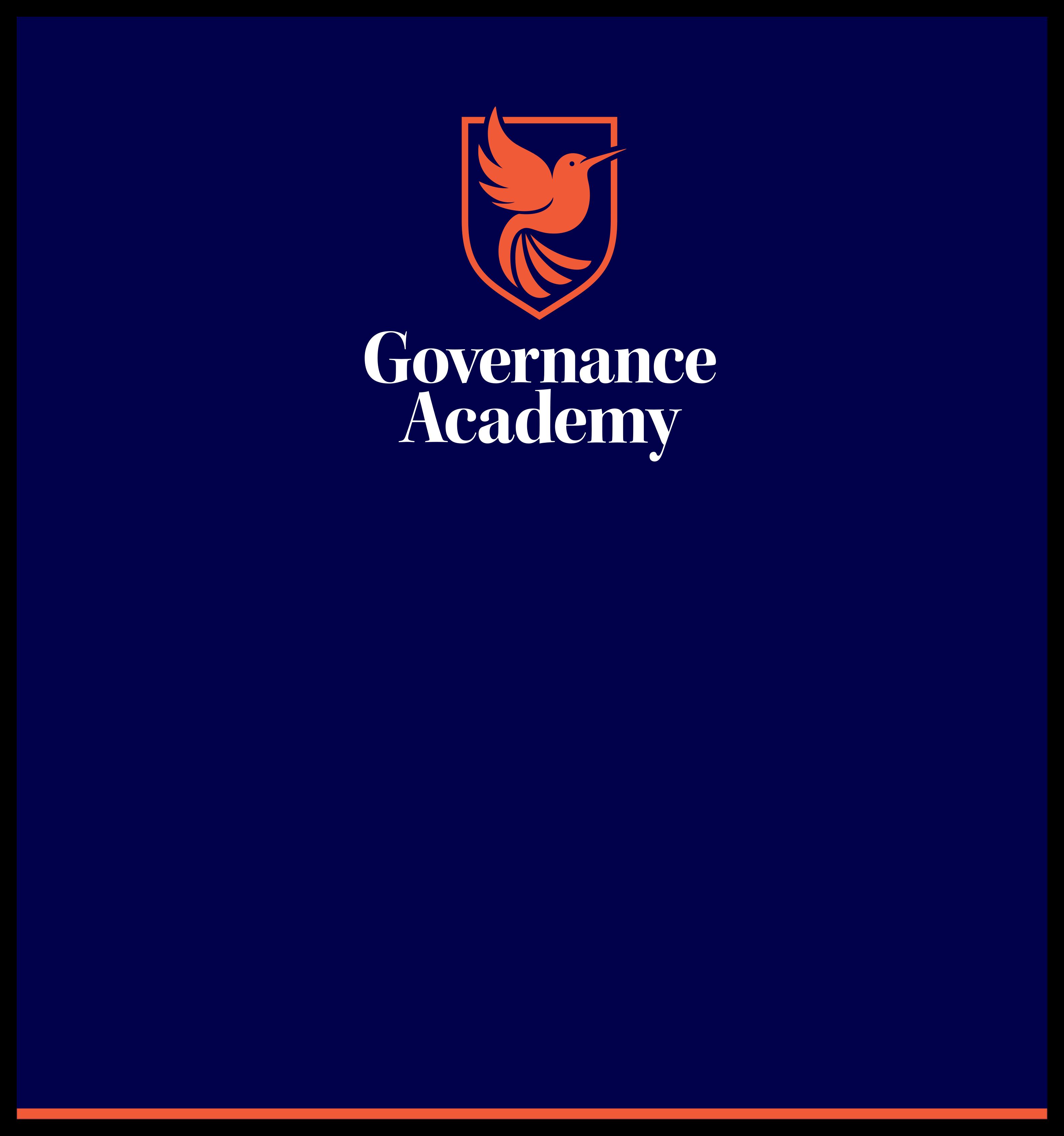

See Micro-credentials


FGIA FCG
by CATHERINE MAXWELL General Manager, Policy & Advocacy, Governance Institute of Australia
GIA Submission – Positioning Australia financial reporting system for the future
Our Submission on Treasury’s proposals to set up a body to combine the Australian Accounting Standards Board (AASB), the Auditing and Assurance Standards Board (AUASB) and the Financial Reporting Council (FRC) noted members’ cautious support – see our Submission December 2022
Our Submission noted that one of the most important aspects of the proposals will be ensuring that the new merged body has an effective governance framework to ensure a clear and shared understanding by all parties of their roles, powers, responsibilities and accountabilities.
This will strengthen accountability and protect against the involvement of key participants in areas reserved for others This is particularly the case since the new body will have both an oversight role, currently the responsibility of the FRC, and a standard setting role, currently the responsibility of the AUASAB and AASB
Preservation of the independence of the standard setting bodies will be critical and our members consider that key matters such as the powers and responsibilities, size and structure and number of the Board and its committees should be set out in the legislation.

We also commented that the AASB and AUASB both have access to individuals with a high variety of skills, experience and expertise and that retaining these skills, expertise and experience will be critical as more entities transition to climaterelated financial disclosure and the sustainability standards are developed We also expressed support for the involvement of the new body in the development of international reporting standards
Our Submission also supported:
A mechanism to disclose conflicts of interest and the replication of the current AASB/AUASB termination provisions for members of the new Board.
Not granting the new Board or the CEO of the new Body power to veto standards.
A majority of independent directors for the new Board which would have the benefit of giving the Board access to industry expertise but make it harder for any individual or small group of individuals to dominate the Board’s decisionmaking and maximise the likelihood that Board decisions will reflect the best interests of the entity and the public interest
A robust process for selection and appointment of suitably qualified individuals to the new Board
A suitable transition period for new arrangements to ensure that the momentum of the current standard setting processes is maintained.
GIA will continue to keep members updated on this issue.
In our Submission to the Review we endorsed LPP as a longstanding principle supporting access to justice and the rule of law and opposition to any weakening of the protection LPP affords and cautioned against interfering with the current legal framework. LPP exists to enable individuals and organisations to get frank and fearless advice from their legal advisers.
We asked for greater detail about the commentary in the Discussion Paper about the improper use of LPP and ‘bad actors’, as our members are not aware of the systemic misuse of LLP by companies and their legal advisers.
Our Submission referred to the significant changes to the operating environment since the COVID-19 pandemic as a result of which many organisations have moved away from hard copy documentation and maintain records electronically
This has led to an exponential increase in the amount of material potentially within scope of requests. We also referred to the fact that even with the use of contemporary technology sifting through this material is a time consuming and expensive exercise.
The increase in multi-disciplinary practices has also complicated claims of LPP We recommended Government work with key stakeholders to develop appropriate guidance for lawyers working in multidisciplinary practices or in dual roles
Our submission also referred to the need for a more consistent approach to LPP across Commonwealth agencies and regulators and to the fact that the sheer number of Commonwealth agencies and the inconsistency between Commonwealth agencies are long-standing issues. We recommended the development of harmonised and consistent protocols/guidance and data retention periods relating to LPP for all Commonwealth agencies and regulators.
We recommended Government work with key stakeholders to develop appropriate guidance for lawyers working in multidisciplinary practices or in dual roles.
One of the issues referred to in our Submission was the ‘breadth’ of the requests received from regulators and agencies. We recommended Government investigate the feasibility of court-appointed LPP examiners to resolve LPP disputes, subject to a right of appeal to the Federal Court.
Governance Institute will continue to keep members updated on this issue.
Our Submission welcomed the Commonwealth Data Retention Review noting that the intention is to manage the exponentially increasing volume of documents and data being retained by Australia’s corporate sector Our Submission referred to the heightened cyber threat environment in which Australian businesses are operating, placing significant financial, reputational and safety risks on corporations, directors, officers and their customers. We expressed support for simplifying and clarifying existing data retention obligations with a focus on minimising unnecessary data retention and for the draft data retention principles outlined in the Discussion Paper.
Our Submission recommended Government:
Consider the adoption of an additional data retention principle that limits regulatory agencies’ powers to make sensitive or personal information publicly available with the aim of minimising to the greatest extent possible the personal safety and identity theft concerns and privacy risks associated with this information
Abolish the requirement for businesses to maintain customer ID data where ID is managed, stored and verified through third-party digital ID service providers.
Review whether the current shared regulatory arrangement between the ACCC and OAIC is driving the required awareness, confidence and trust in third party digital ID service providers, its uptake by the business community, and whether a dedicated regulator may better serve the policy intent of a national ID verification scheme
Review the interaction of corporate criminal responsibility (Part 25) of the Criminal Code Act 1995 with the civil liability penalties for directors and officers in the Corporations Act 2001
Investigate whether the increasingly punitive approaches to corporate wrongdoing has increased the volume of data retained by corporations particularly where data retention obligations may be indirect or implied by Commonwealth legislation and regulation.
Governance Institute will continue to keep members informed about developments.
Submissions

Treasury Consultation paper - Consultation Paper: Positioning Australia’s financial reporting system for the future Designing a single, flexible standard setting body – 21/02/2025
Attorney General’s Department - Discussion Paper: Review of the Use of Legal Professional Privilege in Commonwealth Investigations – 28/02/2025
ACNC - Decision Impact Statement: Equality Australia Ltd and updates to our Commissioner’s Interpretation Statement: Public Benevolent Institutions – 20/03/2025
Attorney General’s Department - Discussion Paper for the Data Retention Review – 14/03/2025
2025-26 Pre-Budget Submission – 31/01/2025

by Catherine Maxwell General Manager, Policy & Advocacy, Governance Institute of Australia



